- 2030년 초강대국 전망과 미국 외교 정책 관련 인식 - Gallup International 다국가 조사
- 조사일 : 2025/02/14
- [GallupReport(20250821)_Superpower_GIA.pdf] 다운로드
● 2025년 8월 21일(목) 공개 | 문의: 02-3702-2571/2621/2622
2030년 초강대국 전망과 미국 외교 정책 관련 인식:
Gallup International 다국가 조사
→ 한국+세계 조사 결과 파일 다운로드(PDF)
/ 세계 조사 개요
· 2024년 10월~2025년 2월 45개국 성인 총 46,195명 전화/온라인/면접조사(주제별 참여국 상이)
/ 한국 조사 개요
· 조사기간: 2024년 11월 11~25일
· 표본추출: 층화 집락 확률 비례 추출
· 응답방식: 면접조사원 인터뷰(CAPI)
· 조사대상: 전국(제주 제외) 만 19세 이상 1,534명
· 표본오차: ±2.5%포인트(95% 신뢰수준)
· 응답률: 28.8%(총 접촉 5,326명 중 1,534명 응답 완료)
· 의뢰처: 한국갤럽-Gallup International 자체 조사
/ 조사 문항(아래 순서대로 질문)
→ 2030년 초강대국 전망: 미국, 중국, 러시아, 일본, 인도, 영국, 유럽연합(EU)
→ 미국의 외교 정책이 자국에 주는 영향
→ 한국 교차집계표
→ (영문) Gallup International commentary
→ 한국 응답자 특성표
요약
[초강대국 전망] 37개국 시민 열에 여섯, 2030년에도 중국·미국 세계 패권 유력시
· 러시아(41%), 일본(36%), 유럽연합(33%), 영국(27%), 인도(22%) 순
· 중국인 97%, 러시아인 66%, 미국인 64%는 2030년 자국이 초강대국일 것이라고 믿어
· 일본인, 유럽연합 대표하는 독일인, 영국인 등은 자국 초강대국론에 회의적, 인도인은 반반
[한국] 2030년 미국 초강대국론 동의율 89%, 37개국 중 최고... 중국에 대해서는 66%
· 한국인 다수는 영국, 일본, 러시아, 유럽연합, 인도를 5년 후 초강대국 감으로 보지 않아
[미국의 외교 정책] 37개국 시민 30% '자국에 긍정적 영향', '부정적' 36%, '영향 없다' 19%
· '긍정적 영향' 상위국: 코소보(71%), 인도(64%), 필리핀(60%), 콜롬비아·우크라이나(51%)...
· '부정적 영향' 상위국: 이란(64%), 독일(59%), 러시아(58%), 이라크(57%), 스웨덴(53%)...
· 우크라이나, 인도·아르헨티나 등에서는 20년 전 대비 미국 영향 긍정론 증가, 한국은 비슷
조사 결과
────────────
2030년 초강대국 전망
────────────
37개국 시민 열에 여섯, 2030년에도 중국·미국 세계 패권 유력시
- 러시아(41%), 일본(36%), 유럽연합(33%), 영국(27%), 인도(22%) 순
- 중국인 97%, 러시아인 66%, 미국인 64%는 2030년 자국이 초강대국일 것이라고 믿어
- 일본인, 유럽연합 대표하는 독일인, 영국인 등은 자국 초강대국론에 회의적, 인도인은 반반
2024년 10월부터 2025년 2월까지 갤럽 인터내셔널이 37개국 시민 37,842명에게 미국, 중국, 러시아, 일본, 인도, 영국, 유럽연합(이하 'EU') 등 7개국 각각에 대해 2030년 초강대국이 될 것으로 생각하는지 물었다(동의 여부, 2점 척도). 그 결과 중국과 미국에 대해서는 각각 63%, 61%가 2030년에도 초강대국일 것이라는 데 동의했고, 그다음은 러시아 41%, 일본 36%, EU 33%, 영국 27%, 인도 22% 순으로 나타났다.
◎ 중국인 97%, 러시아인 66%, 미국인 64%는 2030년 자국이 초강대국일 것이라고 믿지만, 일본인, EU를 대표하는 독일인, 영국인 등은 자국 초강대국론에 회의적이다(부동의 75%, 60%, 58%). 인도인은 낙관과 비관이 비슷하게(44%:39%) 갈렸다.
◎ 한국 조사는 2024년 11월 11~25일 전국(제주 제외) 만 19세 이상 1,534명을 대상으로 했다. 한국인의 7개국 각각에 대한 2030년 초강대국 전망은 미국 89%, 중국 66%, 러시아, 인도 각각 23%, EU 19%, 일본 15%, 영국 14%다. 한국에서는 미국 초강대국론 동의율이 37개국 중에서 가장 높고, 중국을 제외한 다섯 국가에 대해서는 5년 후 초강대국 감으로 보지 않는 시각이 지배적이다.
◎ 갤럽 인터내셔널은 지난 2020년 말에도 같은 질문을 했다. 당시 기준 10년 후인 2030년 중국 초강대국론에 45개국 시민 중 59%가 동의했고, 미국(56%), 러시아(43%), EU(32%), 일본(31%), 영국(25%), 인도(16%)가 뒤이었다. 한국인의 2030년 초강대국 전망은 미국 78%, 중국 70%, EU 28%, 러시아 20%, 인도 14%, 영국 13%, 일본 10%였다(→ G20210304).
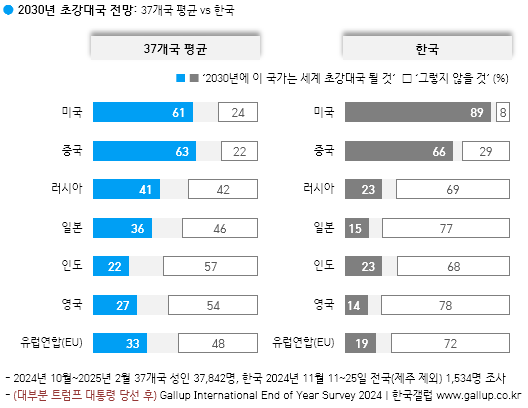
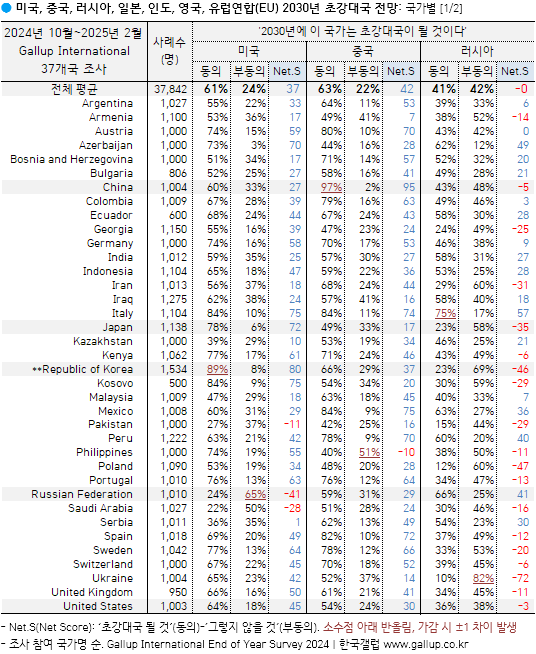
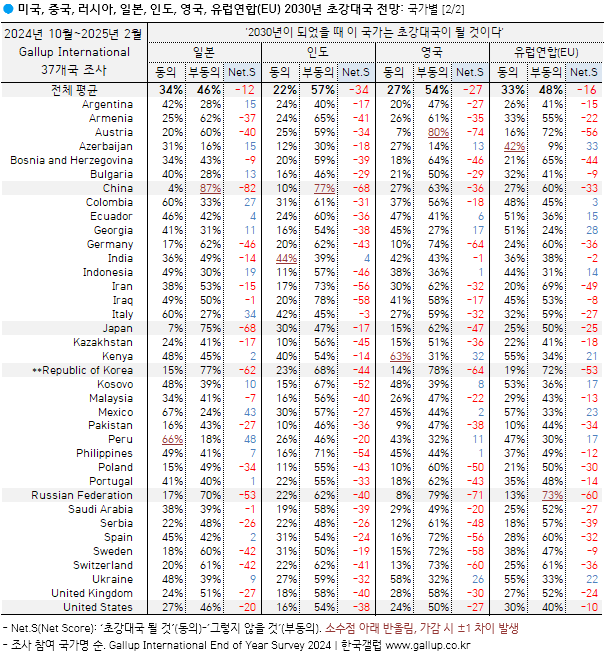
────────────
미국의 외교 정책
────────────
37개국 시민 30% '자국에 긍정적 영향', '부정적' 36%, '영향 없다' 19%
- '긍정적 영향' 상위국: 코소보(71%), 인도(64%), 필리핀(60%), 콜롬비아·우크라이나(51%)...
- '부정적 영향' 상위국: 이란(64%), 독일(59%), 러시아(58%), 이라크(57%), 스웨덴(53%)...
2024년 10월부터 2025년 2월까지 갤럽 인터내셔널이 37개국(선행 질문과는 참여국 일부 다름) 시민 37,321명에게 미국의 외교 정책이 자국에 어떤 영향을 준다고 보는지 물었다. 그 결과 '긍정적 영향' 30%, '부정적 영향' 36%, '영향 주지 않는다' 19%로 나타났다. 15%는 의견을 유보했다.
◎ '긍정적 영향' 응답 상위국은 코소보(71%), 인도(64%), 필리핀(60%), 콜롬비아·우크라이나(51%), '부정적 영향' 상위국은 이란(64%), 독일(59%), 러시아(58%), 이라크(57%), 스웨덴(53%) 등이다.
◎ 이번 조사에 참여한 37개국 중 25개국은 2004년에도 같은 질문을 했다. 미국 외교 정책의 자국 긍정 영향론을 20년 전과 비교하면 우크라이나(15%→51%), 인도(38%→64%), 아르헨티나(16%→42%), 폴란드(23%→40%), 말레이시아(14%→31%) 등에서 15%포인트 이상 증가했다. 반면 불가리아, 조지아, 오스트리아 등에서는 2004년 대비 미국의 외교 정책이 자국에 부정적 영향을 준다는 여론이 크게 늘었다.
◎ 선행 질문에서 한국인은 앞으로도 미국이 세계 패권국 위상을 유지할 것으로 보며, 과거 여러 차례 조사에서도 일관되게 안보·경제적 측면에서 미국 관계를 가장 중시했다(→ 제588호). 그러나 미국 외교 정책에 관해서는 '긍정적 영향' 36%, '부정적 영향' 40%로 비슷하게 나뉘었고('영향 주지 않는다' 19%, 의견 유보 5%), 2004년에도 긍·부정론(35%:43%) 격차가 크지 않았다.
◎ 참고로, 2023년 2월 기준 한국인이 가장 좋아하는 나라(외국, 자유응답)는 미국(22%), 스위스·호주(11%), 캐나다(9%) 순, 싫어하는 나라는 중국(34%), 일본(24%), 북한(17%), 러시아(12%) 순으로 조사된 바 있다(→ G20231012).
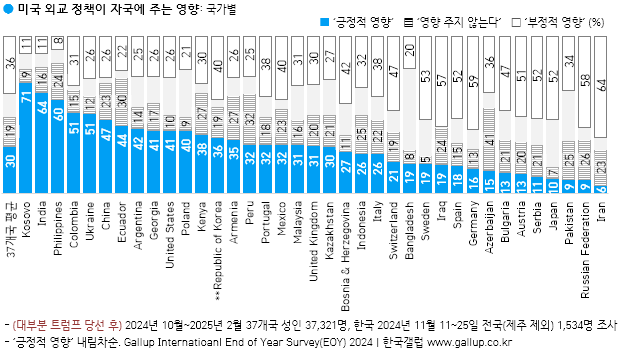
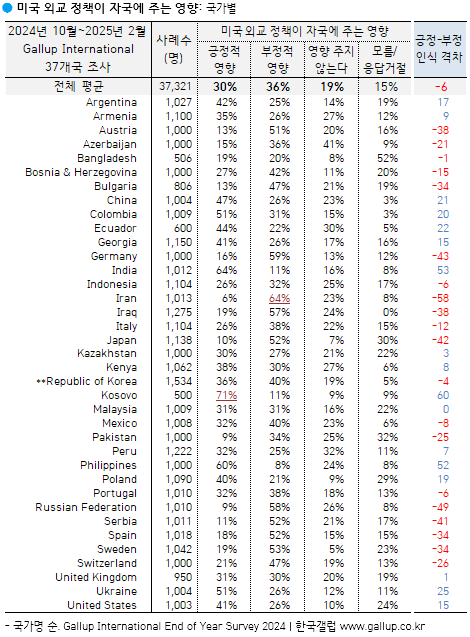
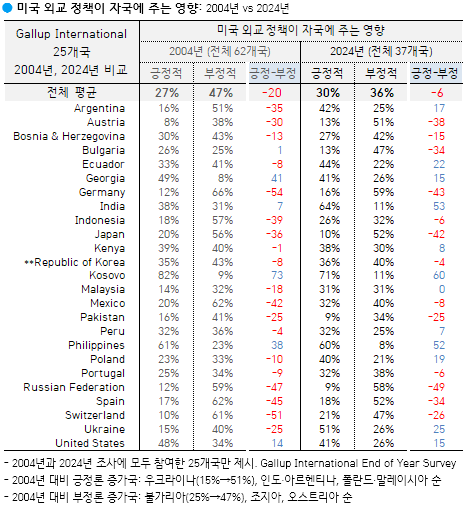
───
한국 교차집계표
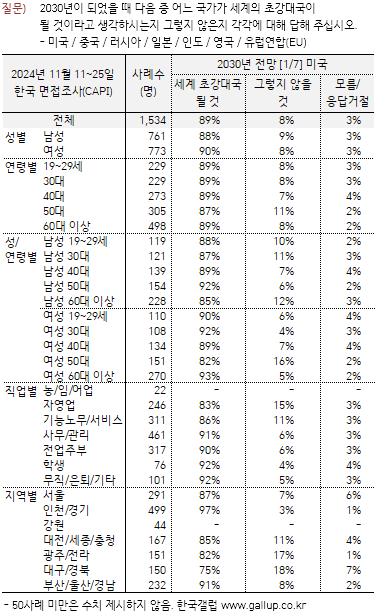
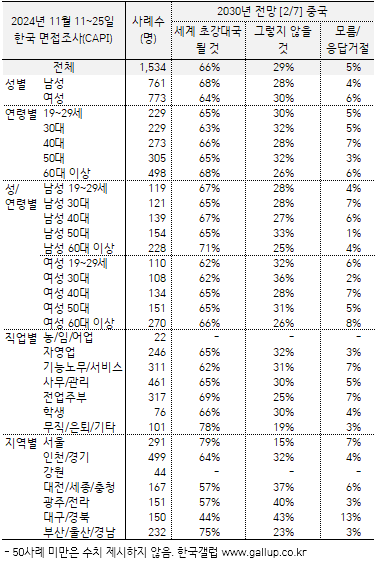
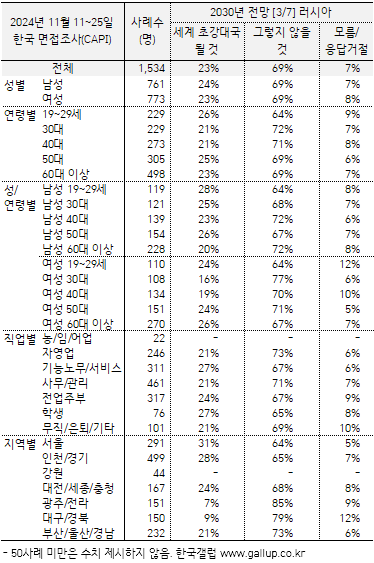
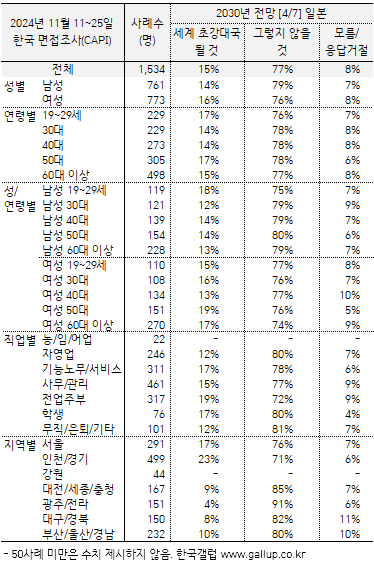
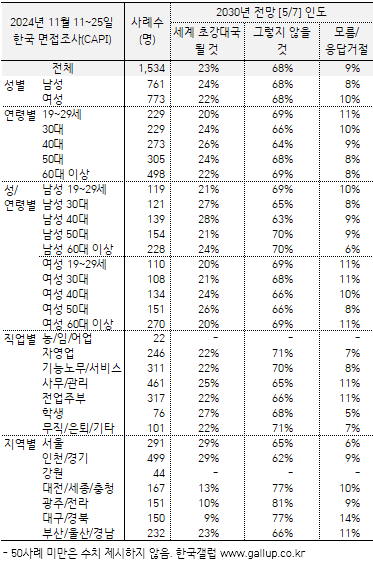
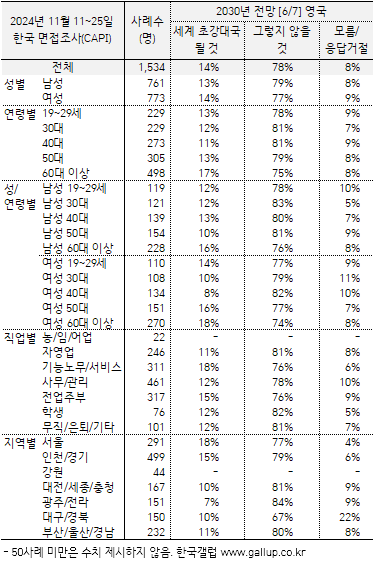
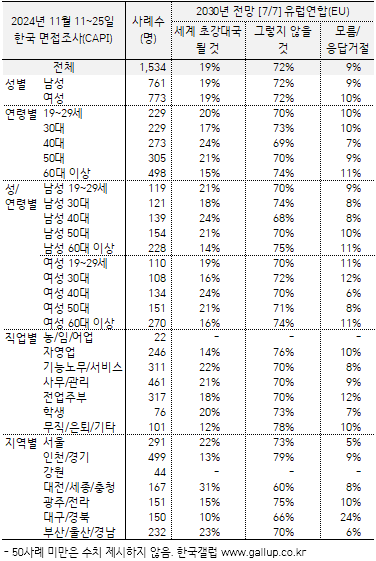
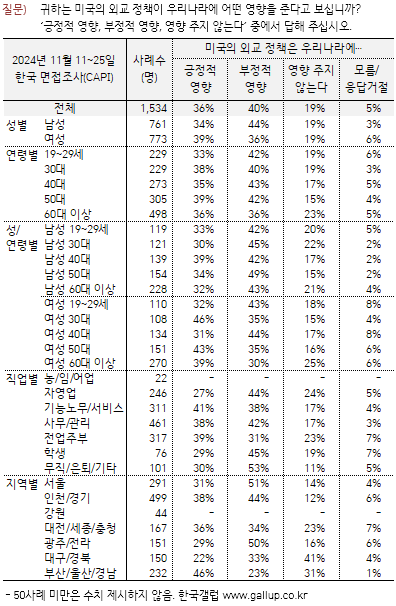
──────────────────
In a world of global competition,
the US and China are tied as superpowers with opinion divided on Russia
──────────────────
We may only be days into the Trump Presidency but the findings from our global survey of 37 countries reveal that citizens see two superpowers, the US and China, significantly ahead of Russia.
When asked whether they consider the US to be a superpower in 2030, 61% say yes while 24% say no. Interestingly in our survey of Chinese adults, 60% agree that the US will be a superpower while the Russia population is a lot more cynical on the role of the US (only 24% see the US as a super power in the future).
Across all 37 countries, 63% agree that China will be a superpower by 2030, with 97% of respondents in China agreeing and 54% of Americans accepting the fact that China will remain a superpower by 2030.
It is perhaps Russia which is most interesting in that opinion is evenly divided. Despite President Putin increasing Russia’s footprint across much of the world and building deeper relationships with non-Western blocs such beyond the EU/US, 41% of all countries surveyed accept that they will remain a superpower by 2030, while 42% saying they will not. Italians (at 75%) are most convinced Russia will remain a superpower by 2030 (more so than Russians themselves with 66% agreeing).
Beyond these three countries there is nobody else competing seriously – even the potential might of the EU bloc is questioned with only 33% saying they will be a superpower, 48% saying they will not. In arguably the most powerful country in Europe, Germans do not think the EU will be a superpower by 2030 (24% say they will, 60% say they will not).
The Impact of US foreign policy
Looking a little deeper at attitudes towards US foreign policy specifically and whether or not our sample of N= 37,321adults see this as having a positive or negative effect on their country, overall, the pendulum is tipped slightly to a negative impact (36%) rather than a positive impact (30%). It is no surprise to see that Iran (64% negative impact) and Russia (58%) view US foreign policy most negatively. Additionally, there are many explanations as to why results from Kosovo (71% positive impact), Philippines (60%) and Ukraine (51%) are most positive towards US foreign policy in their country.
Gallup International asked the same question twenty years ago. The countries showing the largest increases in perceptions of favourability towards the impact of US foreign policy on their country include Ukraine (+36% over twenty years), India (+26%), Argentina (+26%), Malaysia (+17%) and Poland (+17%). Conversely, those countries where attitudes have deteriorated the strongest are Bulgaria (+21% over twenty years), Georgia (+18%) and Austria (+13%).
Michael Nitsche, President of Gallup International comments:
“Two global superpowers continue to dominate the competitive space, while opinions are lot more divided on Russia. President Trump undoubtedly would like to see the US a lot further ahead in this fight for global supremacy and may take the fight on a lot more to his competitors.”
───
한국 응답자 특성표
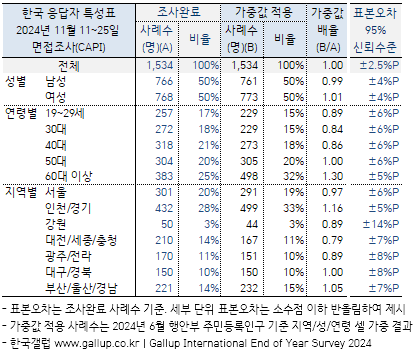
| ● 1947년 조지 갤럽 박사가 설립한 갤럽 인터내셔널(Gallup International Association, GIA)은 1977년부터 전 세계 회원사들이 매년 말 자국민 대상으로 경제, 노동, 국제 관계 등 현안에 대한 인식과 새해 전망을 알아보는 〈End of Year Survey〉를 해왔습니다. 한국갤럽은 1979년부터 참여하고 있습니다. → Press release for the 120th Anniversary of Dr. George Gallup ● GIA End of Year Survey 2024는 2024년 10월~2025년 2월 45개국 성인을 대상으로 했습니다. 〈선호 자녀 성별〉 〈외국에서 오는 이민(移民), 국내 거주 이민족(異民族)〉에 이어 오늘은 〈2030년 초강대국 전망과 미국 외교 정책〉 관련 인식을 전합니다. |
2030년 초강대국 전망과 미국 외교 정책 관련 인식:
Gallup International 다국가 조사
→ 한국+세계 조사 결과 파일 다운로드(PDF)
/ 세계 조사 개요
· 2024년 10월~2025년 2월 45개국 성인 총 46,195명 전화/온라인/면접조사(주제별 참여국 상이)
/ 한국 조사 개요
· 조사기간: 2024년 11월 11~25일
· 표본추출: 층화 집락 확률 비례 추출
· 응답방식: 면접조사원 인터뷰(CAPI)
· 조사대상: 전국(제주 제외) 만 19세 이상 1,534명
· 표본오차: ±2.5%포인트(95% 신뢰수준)
· 응답률: 28.8%(총 접촉 5,326명 중 1,534명 응답 완료)
· 의뢰처: 한국갤럽-Gallup International 자체 조사
/ 조사 문항(아래 순서대로 질문)
→ 2030년 초강대국 전망: 미국, 중국, 러시아, 일본, 인도, 영국, 유럽연합(EU)
→ 미국의 외교 정책이 자국에 주는 영향
→ 한국 교차집계표
→ (영문) Gallup International commentary
→ 한국 응답자 특성표
요약
[초강대국 전망] 37개국 시민 열에 여섯, 2030년에도 중국·미국 세계 패권 유력시
· 러시아(41%), 일본(36%), 유럽연합(33%), 영국(27%), 인도(22%) 순
· 중국인 97%, 러시아인 66%, 미국인 64%는 2030년 자국이 초강대국일 것이라고 믿어
· 일본인, 유럽연합 대표하는 독일인, 영국인 등은 자국 초강대국론에 회의적, 인도인은 반반
[한국] 2030년 미국 초강대국론 동의율 89%, 37개국 중 최고... 중국에 대해서는 66%
· 한국인 다수는 영국, 일본, 러시아, 유럽연합, 인도를 5년 후 초강대국 감으로 보지 않아
[미국의 외교 정책] 37개국 시민 30% '자국에 긍정적 영향', '부정적' 36%, '영향 없다' 19%
· '긍정적 영향' 상위국: 코소보(71%), 인도(64%), 필리핀(60%), 콜롬비아·우크라이나(51%)...
· '부정적 영향' 상위국: 이란(64%), 독일(59%), 러시아(58%), 이라크(57%), 스웨덴(53%)...
· 우크라이나, 인도·아르헨티나 등에서는 20년 전 대비 미국 영향 긍정론 증가, 한국은 비슷
조사 결과
────────────
2030년 초강대국 전망
────────────
37개국 시민 열에 여섯, 2030년에도 중국·미국 세계 패권 유력시
- 러시아(41%), 일본(36%), 유럽연합(33%), 영국(27%), 인도(22%) 순
- 중국인 97%, 러시아인 66%, 미국인 64%는 2030년 자국이 초강대국일 것이라고 믿어
- 일본인, 유럽연합 대표하는 독일인, 영국인 등은 자국 초강대국론에 회의적, 인도인은 반반
2024년 10월부터 2025년 2월까지 갤럽 인터내셔널이 37개국 시민 37,842명에게 미국, 중국, 러시아, 일본, 인도, 영국, 유럽연합(이하 'EU') 등 7개국 각각에 대해 2030년 초강대국이 될 것으로 생각하는지 물었다(동의 여부, 2점 척도). 그 결과 중국과 미국에 대해서는 각각 63%, 61%가 2030년에도 초강대국일 것이라는 데 동의했고, 그다음은 러시아 41%, 일본 36%, EU 33%, 영국 27%, 인도 22% 순으로 나타났다.
◎ 중국인 97%, 러시아인 66%, 미국인 64%는 2030년 자국이 초강대국일 것이라고 믿지만, 일본인, EU를 대표하는 독일인, 영국인 등은 자국 초강대국론에 회의적이다(부동의 75%, 60%, 58%). 인도인은 낙관과 비관이 비슷하게(44%:39%) 갈렸다.
◎ 한국 조사는 2024년 11월 11~25일 전국(제주 제외) 만 19세 이상 1,534명을 대상으로 했다. 한국인의 7개국 각각에 대한 2030년 초강대국 전망은 미국 89%, 중국 66%, 러시아, 인도 각각 23%, EU 19%, 일본 15%, 영국 14%다. 한국에서는 미국 초강대국론 동의율이 37개국 중에서 가장 높고, 중국을 제외한 다섯 국가에 대해서는 5년 후 초강대국 감으로 보지 않는 시각이 지배적이다.
◎ 갤럽 인터내셔널은 지난 2020년 말에도 같은 질문을 했다. 당시 기준 10년 후인 2030년 중국 초강대국론에 45개국 시민 중 59%가 동의했고, 미국(56%), 러시아(43%), EU(32%), 일본(31%), 영국(25%), 인도(16%)가 뒤이었다. 한국인의 2030년 초강대국 전망은 미국 78%, 중국 70%, EU 28%, 러시아 20%, 인도 14%, 영국 13%, 일본 10%였다(→ G20210304).



────────────
미국의 외교 정책
────────────
37개국 시민 30% '자국에 긍정적 영향', '부정적' 36%, '영향 없다' 19%
- '긍정적 영향' 상위국: 코소보(71%), 인도(64%), 필리핀(60%), 콜롬비아·우크라이나(51%)...
- '부정적 영향' 상위국: 이란(64%), 독일(59%), 러시아(58%), 이라크(57%), 스웨덴(53%)...
2024년 10월부터 2025년 2월까지 갤럽 인터내셔널이 37개국(선행 질문과는 참여국 일부 다름) 시민 37,321명에게 미국의 외교 정책이 자국에 어떤 영향을 준다고 보는지 물었다. 그 결과 '긍정적 영향' 30%, '부정적 영향' 36%, '영향 주지 않는다' 19%로 나타났다. 15%는 의견을 유보했다.
◎ '긍정적 영향' 응답 상위국은 코소보(71%), 인도(64%), 필리핀(60%), 콜롬비아·우크라이나(51%), '부정적 영향' 상위국은 이란(64%), 독일(59%), 러시아(58%), 이라크(57%), 스웨덴(53%) 등이다.
◎ 이번 조사에 참여한 37개국 중 25개국은 2004년에도 같은 질문을 했다. 미국 외교 정책의 자국 긍정 영향론을 20년 전과 비교하면 우크라이나(15%→51%), 인도(38%→64%), 아르헨티나(16%→42%), 폴란드(23%→40%), 말레이시아(14%→31%) 등에서 15%포인트 이상 증가했다. 반면 불가리아, 조지아, 오스트리아 등에서는 2004년 대비 미국의 외교 정책이 자국에 부정적 영향을 준다는 여론이 크게 늘었다.
◎ 선행 질문에서 한국인은 앞으로도 미국이 세계 패권국 위상을 유지할 것으로 보며, 과거 여러 차례 조사에서도 일관되게 안보·경제적 측면에서 미국 관계를 가장 중시했다(→ 제588호). 그러나 미국 외교 정책에 관해서는 '긍정적 영향' 36%, '부정적 영향' 40%로 비슷하게 나뉘었고('영향 주지 않는다' 19%, 의견 유보 5%), 2004년에도 긍·부정론(35%:43%) 격차가 크지 않았다.
◎ 참고로, 2023년 2월 기준 한국인이 가장 좋아하는 나라(외국, 자유응답)는 미국(22%), 스위스·호주(11%), 캐나다(9%) 순, 싫어하는 나라는 중국(34%), 일본(24%), 북한(17%), 러시아(12%) 순으로 조사된 바 있다(→ G20231012).



───
한국 교차집계표








──────────────────
In a world of global competition,
the US and China are tied as superpowers with opinion divided on Russia
──────────────────
We may only be days into the Trump Presidency but the findings from our global survey of 37 countries reveal that citizens see two superpowers, the US and China, significantly ahead of Russia.
When asked whether they consider the US to be a superpower in 2030, 61% say yes while 24% say no. Interestingly in our survey of Chinese adults, 60% agree that the US will be a superpower while the Russia population is a lot more cynical on the role of the US (only 24% see the US as a super power in the future).
Across all 37 countries, 63% agree that China will be a superpower by 2030, with 97% of respondents in China agreeing and 54% of Americans accepting the fact that China will remain a superpower by 2030.
It is perhaps Russia which is most interesting in that opinion is evenly divided. Despite President Putin increasing Russia’s footprint across much of the world and building deeper relationships with non-Western blocs such beyond the EU/US, 41% of all countries surveyed accept that they will remain a superpower by 2030, while 42% saying they will not. Italians (at 75%) are most convinced Russia will remain a superpower by 2030 (more so than Russians themselves with 66% agreeing).
Beyond these three countries there is nobody else competing seriously – even the potential might of the EU bloc is questioned with only 33% saying they will be a superpower, 48% saying they will not. In arguably the most powerful country in Europe, Germans do not think the EU will be a superpower by 2030 (24% say they will, 60% say they will not).
The Impact of US foreign policy
Looking a little deeper at attitudes towards US foreign policy specifically and whether or not our sample of N= 37,321adults see this as having a positive or negative effect on their country, overall, the pendulum is tipped slightly to a negative impact (36%) rather than a positive impact (30%). It is no surprise to see that Iran (64% negative impact) and Russia (58%) view US foreign policy most negatively. Additionally, there are many explanations as to why results from Kosovo (71% positive impact), Philippines (60%) and Ukraine (51%) are most positive towards US foreign policy in their country.
Gallup International asked the same question twenty years ago. The countries showing the largest increases in perceptions of favourability towards the impact of US foreign policy on their country include Ukraine (+36% over twenty years), India (+26%), Argentina (+26%), Malaysia (+17%) and Poland (+17%). Conversely, those countries where attitudes have deteriorated the strongest are Bulgaria (+21% over twenty years), Georgia (+18%) and Austria (+13%).
Michael Nitsche, President of Gallup International comments:
“Two global superpowers continue to dominate the competitive space, while opinions are lot more divided on Russia. President Trump undoubtedly would like to see the US a lot further ahead in this fight for global supremacy and may take the fight on a lot more to his competitors.”
───
한국 응답자 특성표
